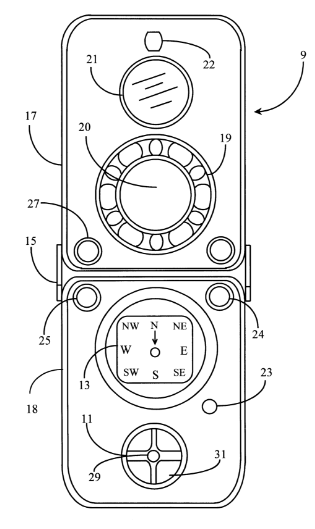Alyssa Resurreccion
Dr. Benedict
English 298
April 16, 2017
Exploring the World Through the Compass
Imagine that you are about to go on a week-long hike, either through the forest or in the mountains, what would you pack in your bag? What comes to mind is possibly a canteen, a sleeping bag, or even a map. While all of these item are essential to a hike, most people do not think to pack one of the most essential tools for the trek. The item I am referring to is the compass, one of the most important inventions in history. The compass is so rarely thought of when one thinks or revolutionary inventions.
The first book that I requested from MASC was “Navigation Spiritualiz’d Or, A New Compass for Seamen” I thought this would be about the actual compass, but it was not. When I first read it, I could not understand what it was saying. After talking to Dr. Benedict, she suggested that it was a metaphorical representation of the compass. In the Observation section of the chapter, it describes the ocean as vast and not to be founded by man. Then, in the Application section, the Heart of Man naturally abounds with monstrous lusts and abominations. Going deeper, one can suggest that navigating the sea can be compared to trying to navigate life. The compass wasn’t just a tool one can physically hold in their hand, but a general concept of trying to get through life.
Its invention has changed cultures all over the world, but not necessarily all in a good way. The aftereffect allowed different cultures to meet and connect, but it also led to environmental and cultural devastation. First I will talk about the ancient ways of navigation and exploration before a form of the compass came along, then about the hopes it helped to create and the lives it helped destroy, and finally about how it helps to reveal part of the human nature.
In the old days, before the compass, travelling was very limited, especially on the seas. Whenever captains needed to sail somewhere, they stayed in sight of land because if they strayed off their path there was not a reliable way to find their way back and risked getting lost at sea. Then celestial navigation was invented. For those who may not know, celestial navigation is navigating by using the stars and constellations as reference points, with even John Harrison inventing the marine chronometer which allowed for seamen to calculate longitude using celestial navigation (Draper). The major downside to these methods is that you always required a clear day, as clouds or fog could severely limit your range of sight, and make it impossible to view the stars or see the physical landmarks that you used to navigate. This could quickly become dangerous as you could sail into uncharted waters and easily get lost. This way of navigating quickly became obsolete with the arrival of the compass.
While the Chinese are usually credited with the invention of the compass, the Encyclopedia of World Trade: From Ancient Times to the Present states that it was, in fact, Muslims that invented the compass during the Middle Ages (Northrup). Although, I cannot locate anywhere else that claims this. Unlike today’s compasses, the Chinese did not use a needle. Instead, they used lodestone, a naturally magnetized mineral that always pointed north. By the eighth century, they were using needles (Northrup). Then came the way that I referred to as the ‘cup and cork’ method. All you need is a bowl of water, a magnetized needle, and a cork. You take the needle and stick it through the cork so that the needle is parallel with the ground, then put the cork in the water. The needle will effortlessly swing to the north direction. Then, magnetized were being set in a housing and on a pivot. I cannot find a date for when this was, but a patent I found for an improvement for a mariners compass was in 1875.
The invention of the compass brought hope to the people of its time. The compass opened up brand new ways of navigating and exploring, mostly maritime exploration. Now that celestial bodies or islands were no longer needed, voyages could be taken longer and farther out. More exploration allowed for the discovery of new lands, specifically the Americas by Christopher Columbus. Christopher Columbus started the trade of spices, technology, and animals between the people of europe and those of the Americas. Each culture started to learn about each other and gain riches, especially the monarchy. It allowed better living conditions for those in europe along with a better standard of living.
While the trading originally brought prosperity to both parties, this quickly changed for the worse for one of the parties involved. Not surprisingly, it was the natives. The natives were quickly colonized by the europeans and subsequently enslaved. Forests and land were quickly cleared to make way for plantations, of which were worked by forced labor. Prince Henry the Navigator also used the compass during his maritime expeditions. He and his team were the first europeans to sail around the African continent (Northrup). His accomplishments ultimately led the way for the enslavement of Africans.
While the invention of the compass did vastly improve navigation and the lives of the inventors, it seemed to do the exact opposite of those on the other side. While the inventors prospered, those who met them were subjugated to awful treatment and lived in poverty. While many lives were saved from its invention, that should not overshadow the overwhelming loss of life that it helped accomplish. Nevertheless, the compass is one of the most prominent inventions in history despite the fact that many people may not know that.
Works Cited
Draper, Charles S. “Navigtion-From Canoes to Spaceships.” (n.d.): n. pag. JSTOR [JSTOR]. Web. 04
Apr. 2017.
Northrup, Cynthia Clark. Encyclopedia of World Trade: From Ancient times to the Present. Armonk,
NY: Sharpe Reference, 2005. 229-31. Print.










